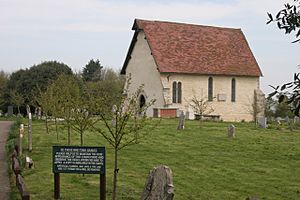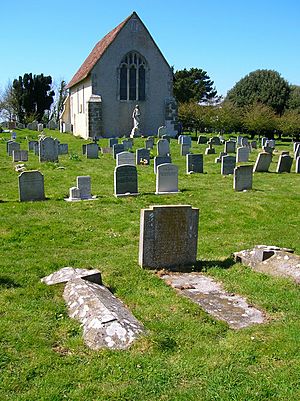St Wilfrid's Chapel, Church Norton facts for kids
Quick facts for kids St Wilfrid's Chapel |
|
|---|---|

The chapel from the southwest
|
|
| 50°45′18″N 0°45′55″W / 50.7549°N 0.7652°W | |
| Location | Rectory Lane, Church Norton, Selsey, West Sussex PO20 9DT |
| Country | England |
| Denomination | Anglican |
| History | |
| Former name(s) | St Peter's Church |
| Status | Church |
| Founded | 13th century |
| Dedication | Saint Wilfrid |
| Dedicated | 1917 (rededicated to St Wilfrid) |
| Architecture | |
| Functional status | Redundant |
| Heritage designation | Grade I |
| Designated | 5 June 1958 |
St Wilfrid's Chapel is an old church building near Selsey in West Sussex, England. It's also known as St Wilfrid's Church or, originally, St Peter's Church. For hundreds of years, from the 1200s until the 1860s, this church was the main church for the village of Selsey.
However, in the mid-1860s, most of the church was taken apart. Half of it was moved to the center of Selsey village and rebuilt there. What was left behind was just the chancel (the part of the church where the altar is). This smaller part became a chapel. It was later renamed after Saint Wilfrid, who founded a monastery in Selsey long ago.
The chapel was used for services until 1990. Since then, it has been looked after by a charity called the Churches Conservation Trust. This tiny chapel is a very important historical building, protected as a Grade I Listed building. It might even stand on the site of an ancient monastery built by St Wilfrid himself!
Contents
History of the Chapel
The area around Selsey is in the very southwest corner of Sussex. It used to be an island, surrounded by the English Channel and Pagham Harbour. Two small communities grew here: the main village of Selsey and a smaller place called Church Norton. Church Norton is about 2.4 kilometers (1.5 miles) northeast of Selsey, right by Pagham Harbour.
Early Beginnings
Many people believe this land is where Ælle of Sussex, the first King of the South Saxons, landed in 477 AD. About 200 years later, Wilfrid (who later became Saint Wilfrid) brought Christianity to this area. He used Selsey as his main base.
In 681 AD, Wilfrid was given land on the island. He used it to start a monastery. This monastery later became a cathedral, and 25 bishops served there between 681 and 1075. After the Norman conquest, a big meeting in London in 1075 decided that the main church should move. It moved from Selsey to the nearby town of Chichester.
Even though the monastery at Selsey was gone by the 11th century, its location remained. By the late 1100s, a church stood on this quiet spot. Some people think it replaced an even older Saxon building, but there isn't much proof.
Building the Original Church
The church grew over time. At its largest, it had a nave (the main part where people sit) with aisles, a chancel, a small bellcot, a porch, and a tower. The oldest parts were the arches in the nave, built around 1180. Soon after, the nave was made longer. The chancel was added in the early 1200s and had simple, tall, narrow windows called lancet windows.
Later, a large east window was added in the Perpendicular Gothic style. Windows were also put into the aisles in the 1400s. A tower with strong supports called buttresses was built at the west end in the 1500s.
Moving the Church
Selsey village started to grow a lot after 1830. New roads and houses were built, and it became a small seaside town. Because Church Norton was far from the growing village, people decided to build a new church in the center of Selsey.
The old church, which was still called St Peter's Church at the time, was partly taken down. Only its chancel was left standing. Some of the stones and materials from the old church were used to build the new St Peter's Church in Selsey. This happened around 1864-1866.
A meeting was held in 1864 to get money to move the church. A wealthy lady, Mrs. Vernon-Harcourt, paid most of the cost. Some people didn't want to see the old church disappear. So, it was agreed that the old church, except for the chancel, would be moved stone by stone to the new site. The building work finished in 1865, and the new church was officially opened in 1866.
Many parts of the old church were moved. These included a Norman-era font, pillars, arches, and three sections of the nave's arches. A bell made in 1844 and some old church items from the 1500s to 1700s were also moved.
The Chapel Today
After most of the church moved, the remaining chancel became a cemetery chapel. It stood in the middle of its graveyard. In 1906, it received some new items from another church that was being taken down. In 1917, the Bishop of Chichester officially renamed the chapel to St Wilfrid's.
Even though it was now part of the new St Peter's Church's area, some services continued there. Beautiful stained glass windows were added in 1969 and 1982. In 1990, the chapel was declared "redundant" by the Diocese of Chichester, meaning it was no longer needed for regular services. Since then, it has been looked after by the Churches Conservation Trust.
The chapel was even mentioned in a poem by Rudyard Kipling called Eddi's Service. The poem tells a story about a priest named Eddi who held a Christmas Eve service even though no one showed up. Instead, an old donkey and a bullock wandered in and stayed to listen! This story is a legend, but it was inspired by Wilfrid's real chaplain, Eddius Stephanus.

A Marriage Mix-Up
When the new church was opened in 1866, there was a small mistake. It wasn't properly set up to hold marriage ceremonies. This wasn't discovered until 1904! By then, 196 marriages had taken place there. While these marriages were correct in the church's eyes, they weren't strictly legal. To fix this, a special law was passed in 1906. This law made all the marriages that happened between 1866 and 1904 officially legal.
Chapel Design and Features
The original church was much larger. It had a main area (nave) with aisles and a tower that was never fully finished. The part that remains today, the chancel, is a simple Early English Gothic building. It still has its original tall, narrow windows on the north and south walls. The large east window, with three sections, was added in the 1400s and is in the Perpendicular Gothic style.
You can still see where the old arch to the chancel used to be on the west wall. The fact that this church is "divided into two halves and standing in two different places" makes it quite unusual!
Inside, there are two special carved areas in the south wall. One of them is used as a piscina, which is a basin for washing sacred vessels. Another old carving shows John Lewis and his wife Agnes, from 1537. It's like a three-part picture, showing them kneeling and facing a central panel. This central part is now too damaged to see, but it would have shown a scene like the Crucifixion. This carving is made from Caen stone. Next to it, another carving shows St George and a scene from the story of St Agatha.
The chapel also has beautiful stained glass windows from the 1900s. One from 1969, by Carl Edwards, honors women. Another from 1982, by Michael Farrar-Bell, shows the nature reserve at Pagham Harbour with its animals and birds.
The Chapel Today
St Wilfrid's Chapel was officially recognized as a Grade I listed building on June 5, 1958. This means it's a very important historical building.
The Diocese of Chichester decided the chapel was "redundant" on November 1, 1990. This means it was no longer used for regular church services. Since then, it has been cared for by the Redundant Churches Fund, which is now called the Churches Conservation Trust. It's one of five old churches in West Sussex that this charity looks after.
As of 2006, special services were still held at the church sometimes. For example, on the feast day of Saint Wilfrid (October 12).
See also
- Grade I listed buildings in West Sussex
- List of churches preserved by the Churches Conservation Trust in Southeast England
- List of former places of worship in Chichester (district)
- Manhood Peninsula
- Selsey Abbey



